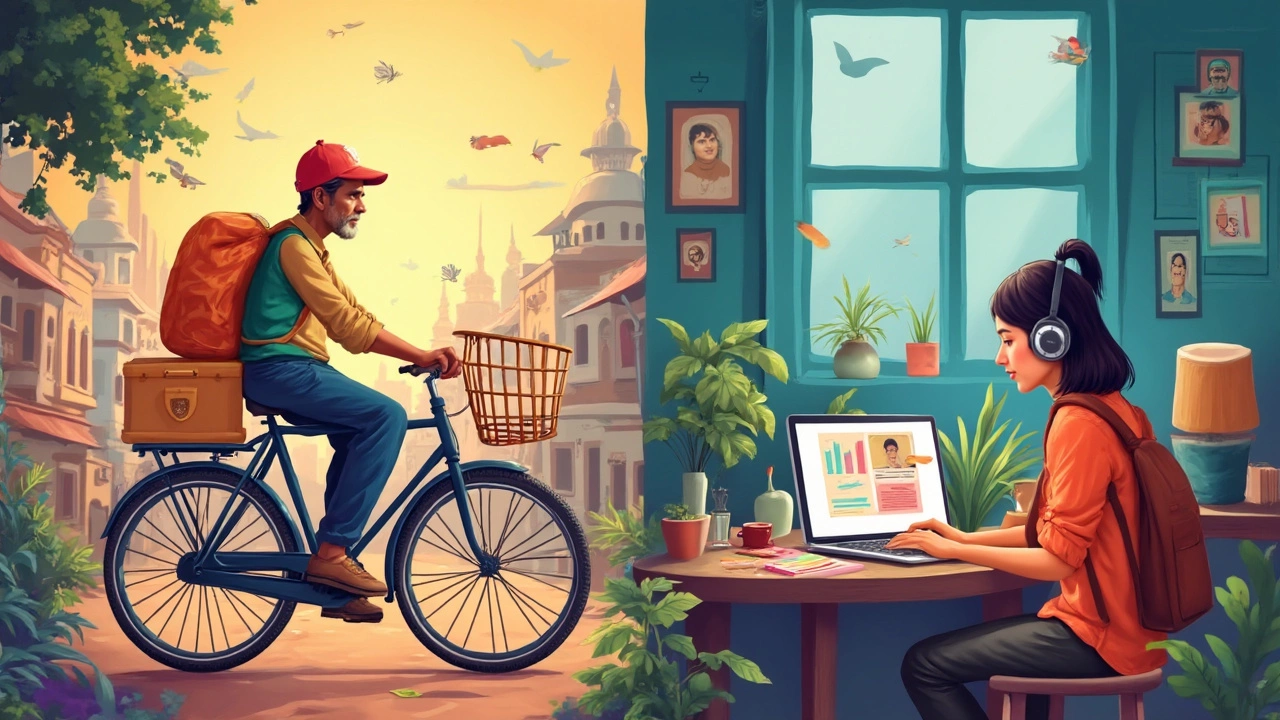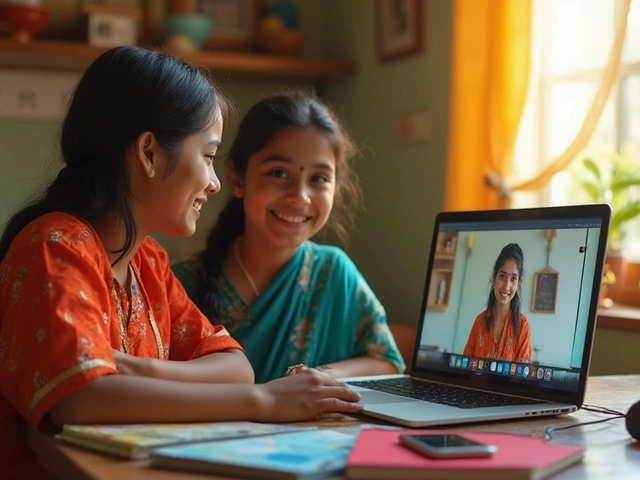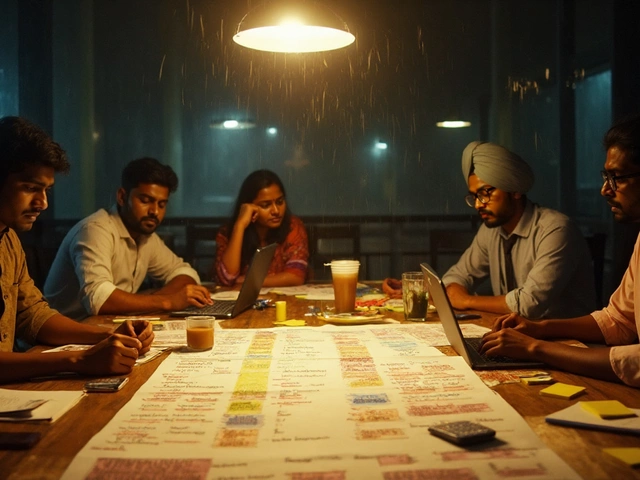
When Did Distance Learning Start? Surprising Origins and Evolution
If you think distance learning started with laptops and Zoom calls, think again. The idea of learning from afar has roots way before the internet even showed up. Imagine people in the 1800s mailing assignments back and forth—yep, that’s how some of the first distance classes worked.
Why was this such a big deal? Not everyone had a college down the street or time to sit in class. So, these early courses gave regular folks a shot at education, even if they lived in the sticks or worked all day. Big names like the University of London and later, the Open University, made distance learning way more legit. They proved you could actually learn something important without being face-to-face with a teacher.
And those old-school foundation stones still matter now. The tech’s just gotten better, letting people pick up new skills or even earn degrees without ever setting foot on campus. Whether you’re looking to boost your career or finally nail that Spanish accent, distance learning’s doors are wide open—and they’ve been swinging for a lot longer than most folks realize.
- The Surprising Early Days
- Mail, Radio, and TV: Teaching Without Walls
- The Computer Era Hits Home
- Internet Revolution and Online Courses
- How the Pandemic Changed the Game
- Making Distance Learning Work for You
The Surprising Early Days
Let’s go way back—distance learning isn’t new. The very first known example popped up in the 1840s. Sir Isaac Pitman, a guy from England, mailed assignments on shorthand writing to his students. His students wrote them out, sent them back, and got feedback by mail. You couldn’t exactly email your homework, but this was a game-changer for people who couldn’t show up in person.
After that, more schools caught on. By 1858, the University of London rolled out its “External Programme.” This allowed students from all over the world to sit exams and get degrees without ever stepping foot in a London classroom. A lot of people couldn’t believe it would work until graduates started getting real jobs—suddenly, remote education earned real respect. In the US, the trend followed: the oldest known distance learning ad appeared in 1873 for “The Society to Encourage Studies at Home,” run mostly by and for women who wanted real training.
Want numbers? Check out how fast this concept grew, even before telephones showed up:
| Year | Milestone | Location |
|---|---|---|
| 1840s | Pitman's Shorthand lessons by mail | UK |
| 1858 | University of London External Programme launched | UK |
| 1873 | First distance learning program for women | USA |
| 1892 | University of Chicago starts correspondence courses | USA |
If you think about it, these early moves tore down a lot of barriers—class, distance, gender. Plus, they set the stage for everything that came next, from radio classrooms to the first online degrees. Were these old schools worried about losing control? Sure. But students loved being able to learn on their own schedule, even if it meant waiting weeks for feedback by mail.
Mail, Radio, and TV: Teaching Without Walls
It’s wild to think about, but distance learning started way before anyone could imagine streaming classes on a phone. Let’s go back to the 1800s, when mail was the biggest tech around. The University of London set a milestone in 1858 by launching what’s now known as external programs. People could study from home, send in their homework by post, and get marked by real professors. This mail-based setup became a lifeline for folks who couldn’t show up in person—think factory workers, single moms, or people stuck miles from a real college.
By the 1920s, radio was the next big thing to hit education. The University of Wisconsin in the U.S. started broadcasting courses over the air in 1922. Suddenly, folks could tune in to learn math, science, or even foreign languages from their living rooms. No stamps needed. Some stations even ran entire lesson series with tests you could mail in after finishing the course. These were huge steps in making education more accessible, and honestly, a bit ahead of their time.
Then TV showed up, and remote classes got even more interesting. In the 1950s, places like the Midwest Program on Airborne Television Instruction (MPATI) used planes to beam educational programs to schools and homes across huge areas. PBS, launched in the late ’60s, added everything from early math for little kids to advanced science classes teens could take for real credit. A lot of these lessons were paired with printed workbooks so you could follow along or do practice exercises after the show.
Each step—mail, radio, then TV—made learning at home more practical, not just a backup for in-person classes. The best part? These methods proved that learning doesn’t have to be stuck inside classroom walls. If you’ve got a drive to learn, these old-school hacks show you don’t need much to get started—just a little creativity, basic tech, and the support of a few forward-thinking educators.
The Computer Era Hits Home
Things changed fast once computers showed up in homes during the '80s and '90s. No more mailing worksheets or waiting for TV broadcasts—suddenly, students could plug in a floppy disc and launch programs right from their desk. By the mid-1990s, about 22% of higher ed institutions in the U.S. were offering courses partly online. That number kept shooting up, making remote learning more normal for everyone.
Colleges started rolling out CD-ROM courses you could finish at your own pace. Some schools even handed out dial-up internet accounts. The University of Phoenix was a major player—it launched its online campus in 1989, letting adults squeeze in studies between job and family time. By 1997, over 70,000 students were enrolled in online courses there alone.
Big companies spotted an opportunity, too. IBM, for example, switched much of its workforce training to online programs by the end of the '90s. People noticed that learning from home wasn’t just a fad. Even The New York Times wrote:
"The internet is changing the way we learn as much as it changed the way we shop, date, or travel."
The main draw? Flexibility and reach. Suddenly, you could join a class with folks from all over, anytime you wanted. Schools built sprawling libraries of materials online—articles, quizzes, message boards—all just a click away.
Check out how fast this grew:
| Year | US Students in Online Courses (millions) |
|---|---|
| 1997 | 1.6 |
| 2002 | 3.2 |
| 2010 | 6.1 |
When people talk about distance learning today, most picture a screen and keyboard. But looking back, it’s wild to realize how fast things moved once computers hit the scene. If you grew up in that era, you’ll remember waiting for dial-up to connect—or maybe installing a course from ten different floppy disks. All of this paved the way for the slick, live video lessons we have now.
If you want to make the most of learning online these days, pick courses with lots of interactive tools, chat groups, and fast feedback. That’s the real legacy of the computer revolution—it made education hands-on and just a bit more fun for everyone.

Internet Revolution and Online Courses
The 1990s blew the doors right off traditional classes. When the internet hit homes, distance learning changed overnight. Suddenly, universities weren’t the only game in town. People could log on, connect with teachers, and hand in work without a single stamp or TV antenna. The University of Phoenix went online in 1989, one of the first to dip a toe into web classes. By the late ‘90s, MIT’s OpenCourseWare and other free resources started popping up. Knowledge was everywhere.
Fast forward to the early 2000s. The explosion of personal computers and faster web speeds made it easy for anyone to take a class from just about anywhere. Blackboard and Moodle became go-to platforms for schools to manage lectures, quizzes, and assignments. More and more colleges put whole degree programs online. The learning curve got a whole lot steeper—and easier for students who needed flexible options.
Then came the massive open online courses, or MOOCs, around 2012. Coursera and edX changed the rules again, letting tens of thousands of people join the same class at once. You could watch lectures from a Stanford professor in your pajamas or chat with students from Brazil, Germany, or Japan in the same course forum.
- Online degrees started carrying real weight on job applications.
- Video streaming made live classrooms and Q&A possible, not just pre-recorded lessons.
- Mobile apps let folks learn during lunch breaks or train commutes.
- Certificates and micro-credentials popped up, letting people rack up skills fast.
The best part? All this made education less of a privilege and more of a basic option. With just a working laptop and Wi-Fi, anyone could jump into a college-level class. Sure, there were growing pains—like scams, tech issues, and screen fatigue. But the payoff was huge: anyone, anywhere, could finally learn what they wanted, when they wanted.
How the Pandemic Changed the Game
When COVID-19 hit in 2020, distance learning went from being an option to basically the only way people could go to school or college for a while. Schools and universities everywhere had to shift things online—fast. It wasn’t always smooth, but it made everyone see that remote learning could actually work on a big scale. The whole system had to pivot almost overnight.
Check out how things changed in numbers:
| Year | Percent of US College Students in Any Online Course | Percent of K-12 US Schools Using Remote Tools |
|---|---|---|
| 2019 | ~37% | ~20% |
| 2020 | ~75% | >90% |
This wasn’t just a blip. Even after classrooms reopened, lots of people stuck with some form of online learning. For example, my nephew, who hated tech stuff, started using video chats and apps for group projects because his school had no choice. Now he prefers it for some classes.
Here’s why the pandemic made such a massive difference:
- It forced schools and teachers to get creative and use all kinds of new digital tools.
- Families got more involved—some parents even had to learn how Google Classroom works.
- Some people without computers at home finally got connected, since schools loaned out laptops and Wi-Fi hotspots.
The wild part? Companies like Zoom and Google Meet exploded in popularity almost overnight. Students, teachers, and even folks at work all hopped on these new tools. It made the whole concept of distance learning way more normal and even necessary.
Now that the dust has settled, a lot of places keep hybrid options around. Flexibility is the new normal. The pandemic pushed distance learning into the spotlight and honestly, it’s never going back in the shadows.
Making Distance Learning Work for You
So, you want to make the most out of distance learning? It’s all about playing smart with your time, your tech, and your schedule. Tons of people have finished degrees or learned totally new skills from their living rooms, so you’re not alone here. In fact, the National Center for Education Statistics found that over 7 million U.S. college students took at least one distance course in 2023.
Getting the hang of remote learning might take a minute, but a few changes can make it way easier. Here’s what usually pays off, based on what real students and teachers say actually works:
- Stick to a routine: Don’t wing it each day. Block out regular study times just like you’d show up for a class in person.
- Set up your own learning space: Even if it’s just a section of the kitchen table, having a “school zone” helps your brain switch into learning mode.
- Use tech tools to your advantage: Calendar reminders, online to-do lists, and video lectures are your friends.
- Reach out early and often: Don’t wait if you’re stuck. Email the teacher, join group chats, or jump into discussion boards. Chances are, someone else has the same question.
- Limit distractions: Phone off, TV off, and ask family to give you some quiet. Every little bit helps.
If you want to see how folks are actually doing in this new learning world, take a look at this snapshot:
| Year | US College Students in Distance Learning | Percentage Completing On Time |
|---|---|---|
| 2015 | 5.8 million | 63% |
| 2020 | 7.3 million | 66% |
| 2023 | 7.1 million | 69% |
What does the data say? More students are turning to online classes, and a growing chunk are finishing on time. That’s a good sign that distance learning isn’t just a last resort anymore—it actually works if you play your cards right.
One more tip: Mix in breaks and give yourself rewards for finishing tasks—kind of like giving yourself gold stars. You’d be surprised how far those little boosts will push you through the tough lessons and tech hiccups.






Write a comment